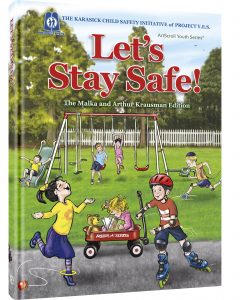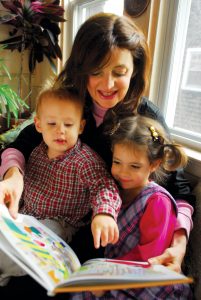Up Close with Bracha Goetz
A Harvard graduate who just came out with her thirty-third book discusses her decades-long career as a writer of Jewish children’s books
By Avigayil Perry
How did you get started as a children’s author?
I always loved reading as a child. Even as an adult, I am drawn to children’s books.
I like to write about deep subjects in a simple way, to simplify a deep concept and bring it down to a child’s level. I like getting to the crux of an issue. I’m not a person of many words. I don’t like a lot of embellishment.
I wrote my first book while watching my children on the playground. I decided to send it to a publisher, but I had no expectations, so I was surprised to receive an acceptance letter not long after.
What are your favorite children’s books?
My favorite books are Dr. Seuss, Charlotte’s Web, Stuart Little, The Catcher in the Rye and The Diary of Anne Frank. I also love Winnie the Pooh by A. A. Milne, the Peanuts comics by Charles Schulz and especially the Happiness Is… books by Lisa Swerling and Ralph Lazar. I enjoy works that use words sparingly, and yet manage to be both deep and delightful.
What are key elements that make a children’s book work?
Children love seeing pictures of children. They love funny illustrations with vibrant colors. They also love repetition, but take care—a children’s picture book shouldn’t be too didactic. The book Is it Shabbos Yet? by Ellen Emerman is full of repetition and so many wonderful messages—the kinds of preparation involved in making Shabbos, the joy of Shabbos and the bond between the mother and daughter.
My What Do You See? series [a word-and-picture book series for toddlers—What Do You See at Home?; What Do You See on Shabbos?, et cetera] subtly contains vital concepts, such as the need to express gratitude and include everyone in games. If the books are enjoyable, children don’t realize that they’re internalizing these messages. Lessons about simchah and giving, for example, are readily absorbed into a child’s neshamah.
How do you get your ideas?
I like to write books that I wish I’d had as a child, as I didn’t grow up frum. Often I read a non-Jewish book and realize we need a Jewish version. This is how the What Do You See series came about.
One of my newer books is called Secrets of the Aleph Beis. I am fascinated by the aleph beis. The book describes how the shape of each letter is meaningful. As my introduction states, “At 22, I found 22 new letters that gave my life new meaning.”
Sometimes I see a need, and the idea evolves from there. [For example,] I saw a need for frum children to appreciate nature. Remarkable Park opens a child’s eyes to lessons from nature. Other times I’m asked to write certain books. Not long ago, I was asked by Chevrah Lomdei Mishnah to write a book that teaches children how to keep a connection to someone who passed away. I Want to be Famous is about how shining one’s inner spotlight is far more essential in life than yearning to have a spotlight shine on a person externally. How a soul shines is what really matters. The book contains a quote from Rabbi Yisrael Salanter even though it’s published by a non-Jewish publishing company.
Have you seen the Jewish children’s market change over time? And if so, how?
In 1982, I didn’t have a computer; I used a typewriter. I had to wait around for letters to arrive from publishing companies. Today, with e-mail, I receive an answer immediately. I also have more say over the design.
Today, there is also greater receptivity to publishing books on difficult topics. It took four years to get Let’s Stay Safe published. [The book includes information about providing protection from abuse.] Talking About Private Places [about the dignity and respect with which our bodies are to be treated] took even longer to get published.
Hashem’s Candy Store took time as well—the book raises awareness about eating healthfully. Many schools give out soda cans [and other sugary treats] as prizes, which does not promote children’s health.
Ba’alei teshuvah are often not okay with just accepting the status quo; we look to improve certain areas within the frum community.
I have heard that writing for children is much harder than it looks. Why is that?
[For me,] writing children’s books flows naturally. [Though the editing process may be slower,] getting into a child’s head is not difficult for me. I tend to see the world through a child’s perspective, with a sense of wonder.
Picture books need to provide a lot of joy. An important aspect of parenting is filling the home with joy.
What I find most meaningful is when my writing affects a child; the effect can last a lifetime. I get e-mails from people around the world telling me how my work affected them. One Friday night, we had a family over for the Shabbos meal. One of our guests, a twenty-one-year-old young man, was shocked to find out that I was the author of The Happiness Box. As a child, he had experienced bullying. To cope with the bullying, he would go into his homemade happiness box where he got to practice his happiness skills. He explained to me how this book helped him focus on what was positive in his life so he could cope and eventually thrive.

Reproduced from Let’s Stay Safe, with permission from the copyright holders, ArtScroll/Mesorah Publications, LTD
Which work do you consider to be your best?
I consider Let’s Stay Safe and Talking About Private Places to be my most important published books. My favorite book is Hashem’s Candy Store because I love Dena Ackerman’s wonderfully whimsical illustrations. Aliza in MitzvahLand teaches children that we are in this world to be givers, not takers. My children learned not to be bored—there are always mitzvot to do.
Let’s Appreciate Everyone was written after my granddaughter was born with disabilities. Everyone kept saying, “Now, you’ll write a book about disabilities.” And that’s what ended up happening because my eyes were opened and I became more sensitive to the issues affecting children with disabilities.
Recently, I started to write books for the general public, not only the frum community.
You touch upon certain sensitive topics in your books. Can you explain what caused you to tackle these topics?
Through my work as director of the Jewish Big Brother Big Sister Program (JBBBS) of Jewish Community Services in Baltimore, I have become aware of sexual abuse and how it affects children. Sexual abuse also affected my own family. I didn’t have a book to teach my children about sexual abuse awareness and prevention when I raised them. I taught my children about stranger danger but I didn’t know that far more often, it is a familiar person who presents this type of danger. I saw a gap that I felt was vitally important to fill.
What advice would you give to a child who wants to be a writer?
Everyone carries stories within them. I tell people that it takes twenty years and twenty minutes to write a story—twenty years to sit down and write, and twenty minutes to actually write the first draft. Just do it! I have been rejected so many times. The day I receive a rejection, I try to send out a manuscript again right away. That keeps the momentum going.
What are you working on now?
A number of projects. For a new publishing company, Jewish Children’s Book Club, I am working on a book based on Where’s Waldo? that is about looking for hidden mitzvot, and also a book about the courage of Daniel. I just completed my thirty-third book called Where’s God? The book, which was written for a general audience, is about a boy who searches for God. The book answers the questions that children everywhere ask in a way that fills their souls. It Only Takes a Minute, to be published by HaChai, demonstrates the amazing things we can accomplish in a very short time.
We are all here to accomplish unique missions in this world. I have a magnet on my fridge that says, “Here is a test to find out if your mission in life is finished. If you’re alive, it isn’t.”
Avigayil Perry lives in Norfolk, Virginia, with her family and writes for various Jewish publications.

